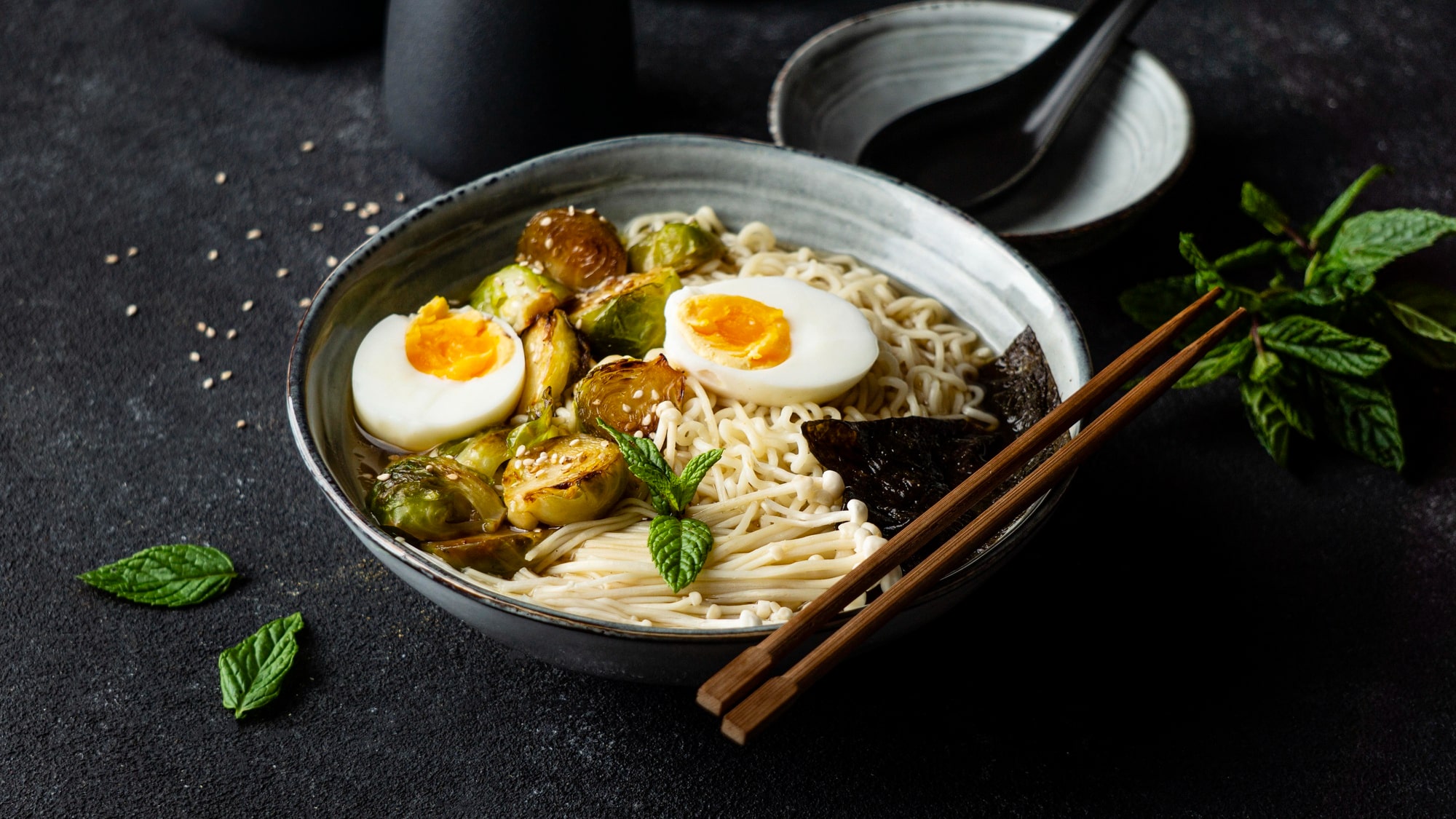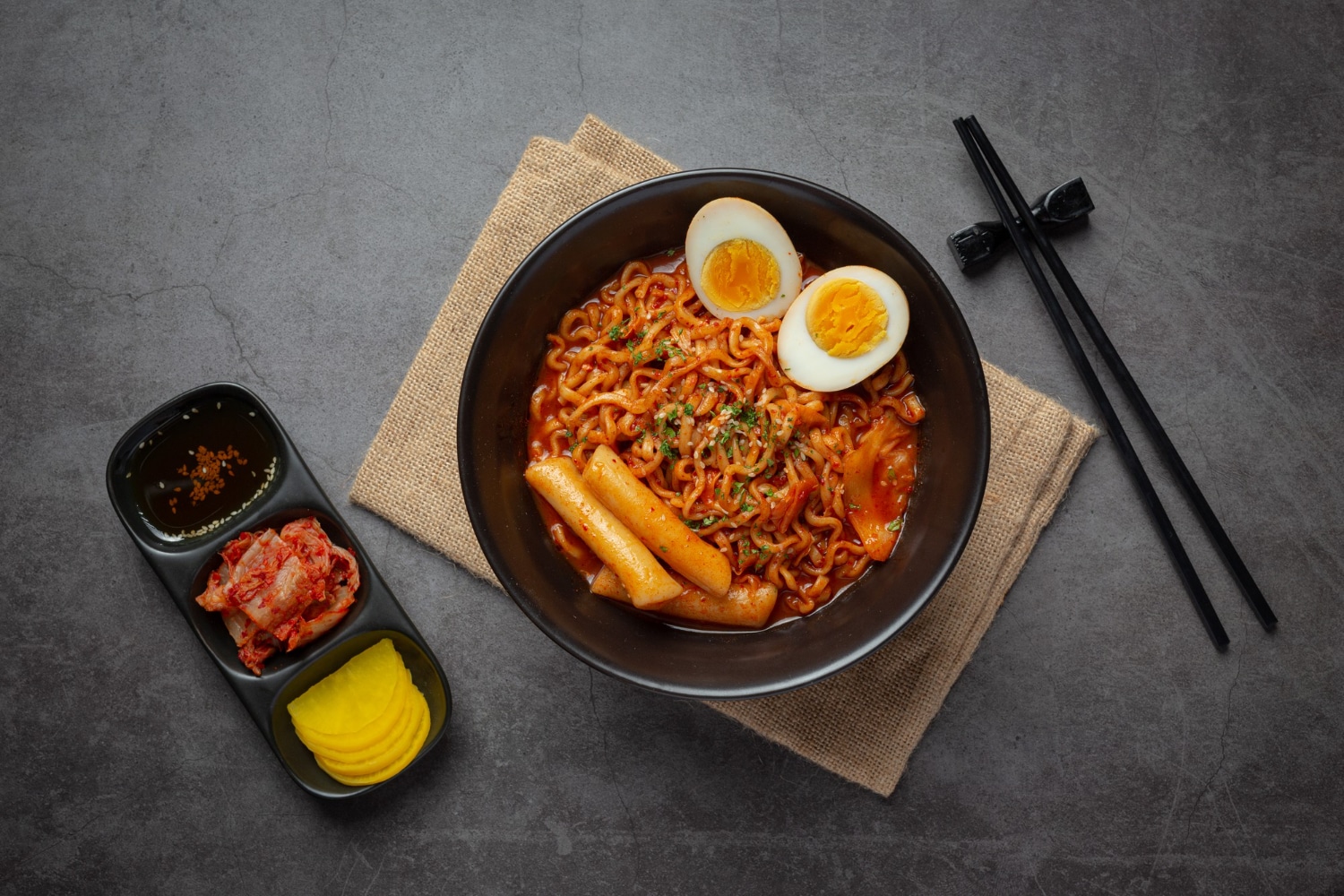Ramen noodles are a Japanese dish with Chinese origins. The dish is a global culinary sensation. While instant ramen is convenient, creating homemade ramen allows you to personalize the dish to your liking. Today, let’s talk about a delicious homemade ramen recipe.
Delicious Homemade Ramen Recipe
Ingredients For Broth
- 2 lbs pork bones (or chicken bones for a lighter broth)
- 1 large onion, halved
- 1 ginger root (about 3 inches), sliced
- 4 garlic cloves, crushed
- 1 cup dried shiitake mushrooms
- 1 cup bonito flakes
- 1/2 cup soy sauce
- 1/4 cup mirin
- Salt to taste
For the Noodles
- 2 cups all-purpose flour
- 1/2 cup water
- 1 teaspoon kansui (alkaline mineral water) or baking soda
For the Toppings
- 1 lb cha shu pork, thinly sliced
- 4 soft-boiled eggs
- Bok choy, blanched
- Bean sprouts
- Scallions, finely chopped
- Nori sheets, toasted and shredded
- Sesame seeds toasted
Step By Step Guide To Make Homemade Ramen

- In a large pot, bring pork bones to a boil and let them simmer for 10 minutes.
- Discard the water and rinse the bones.
- Return bones to the pot with onion, ginger, garlic, shiitake mushrooms, and bonito flakes.
- Add enough water to cover the ingredients and simmer for at least 4 hours.
- Strain the broth and return it to the pot.
- Add soy sauce, mirin, and salt to taste. Simmer for an additional 30 minutes.
- Mix flour and water in a bowl until a dough forms.
- Knead the dough on a floured surface until smooth.
- Wrap the dough in plastic wrap and let it rest for 30 minutes.
- Roll out the dough and cut it into thin strips for noodles. (Read below for detailed noodle recipe)
- Boil the noodles in salted water until al dente. Drain and rinse with cold water.
- Roll pork belly into a log and tie it with kitchen twine.
- Cook in a soy-based marinade until tender, then slice thinly.
- Boil eggs for 6 minutes, then transfer them to an ice bath. Peel and set aside.
- Quickly blanch bok choy and bean sprouts in hot water.
- Divide cooked noodles among serving bowls.
- Pour hot broth over the noodles and arrange toppings on top.
- Sprinkle with scallions, shredded nori, and toasted sesame seeds.
- Place a soft-boiled egg on the side.
Tips for Extra Deliciousnes
- Add a splash of sesame oil or chilli oil for an extra kick.
- Let the chashu pork marinate in the fridge overnight for deeper flavours.
- Customize your ramen with additional toppings like bamboo shoots, corn, or even a dollop of miso paste.
- Enjoy your homemade ramen immediately while it’s hot and flavorful.
- Add miso paste, soy sauce, or mirin to the broth for extra depth.
- Experiment with spice levels by adding chilli paste or sriracha.
- Tailor toppings to your taste, incorporating mushrooms, bamboo shoots, or different proteins.
- Broth and toppings can be prepared in advance for quick assembly.
Innovatie Ramen Variations
- Infuse your broth with curry spices for a rich and aromatic twist.
- Top with shredded chicken, boiled eggs, and cilantro.
- Use flavours like lime, cilantro, and avocado for a fresh and zesty profile.
- Consider adding grilled corn and black beans as unique toppings.
- Explore alternative flours like rice or buckwheat to make gluten-free noodles.
- Ensure your broth and toppings align with specific dietary needs.
- Substitute traditional noodles with spiralized vegetables like zucchini or shirataki noodles for a low-carb alternative.
- Serve ramen cold with refreshing ingredients like cucumber, pickled radishes, and a light soy-based dressing.
- Intensify your broth with warming spices like ginger and garlic.
- Include hearty toppings like braised beef or spicy kimchi.

Tips To Make Perfect Gooey Noodles For Ramen
When making homemade ramen, its important that you maintain that perfect chewy texture of noodles.
- In a large mixing bowl, combine the all-purpose flour and kansui (or baking soda).
- Gradually add water to the well while mixing with a fork or chopsticks.
- Once the dough starts to come together, use your hands to knead it into a rough ball.
- Transfer the dough to a lightly floured surface and knead it for about 10-15 minutes until it becomes smooth and elastic.
- Wrap the dough in plastic wrap and let it rest for at least 30 minutes. This allows the gluten to relax, making the noodles chewier.
- Cut the rested dough into smaller portions for easier handling.
- Roll out each portion into a thin sheet, about 1-2 millimeters thick. Use a rolling pin for consistency.
- Dust the sheet with flour to prevent sticking, then fold it and cut it into thin strips for noodles.
- Bring a large pot of water to a rolling boil. Add a generous amount of salt to the water.
- Gently drop the noodles into the boiling water. Stir to prevent sticking.
- Cook the noodles for 2-4 minutes or until. Fresh noodles cook faster than dried ones.
- Drain the noodles and rinse them under cold water to stop the cooking process. This helps maintain the desired chewy texture.
- Aim for consistent thickness throughout the sheet to ensure even cooking.
- If available, a pasta machine can help achieve an even thickness and streamline the process.
- Explore different flours like bread flour or a combination of flours for varied textures.
- Depending on the humidity in your environment, you may need to adjust the amount of water. Add gradually until the dough comes together.
- If kansui is unavailable, use baking soda as a substitute. Adjust the quantity based on the alkalinity desired.
How Can You Store Homemade Ramen?
Storing Raw Ramen Noodles
- If you’ve made or bought fresh homemade noodles, they can be refrigerated for a short period, usually up to 2-3 days.
- Store the noodles in an airtight container or wrap them in plastic wrap to prevent drying.
- Raw noodles can be frozen for a more extended storage period. Flash-freeze individual portions on a tray before transferring them to a freezer bag.
- Cook frozen noodles directly from the freezer without thawing.
How To Store Cooked Homemade Ramen Noodles
- For the best texture, consume cooked noodles immediately after boiling.
- If not using right away, toss the noodles in a bit of oil to prevent sticking.
- Cooked noodles can be stored in the refrigerator for 1-2 days.
- Place them in an airtight container or a plastic bag.
- Freeze cooked noodles by spreading them out on a tray and then transferring them to a freezer bag once they are individually frozen.
- Reheat frozen noodles by placing them directly in hot water or adding them to the simmering broth.
Storing Ramen Broth
- Broth can be refrigerated for 3-4 days.
- Allow the broth to cool before transferring it to an airtight container.
- Freeze broth in portions using freezer bags or containers.
- Leave some space for expansion when freezing liquids.
- When ready to use, thaw frozen broth in the refrigerator or by placing the container in cold water.
- Reheat on the stove, bringing it to a gentle simmer.



